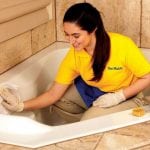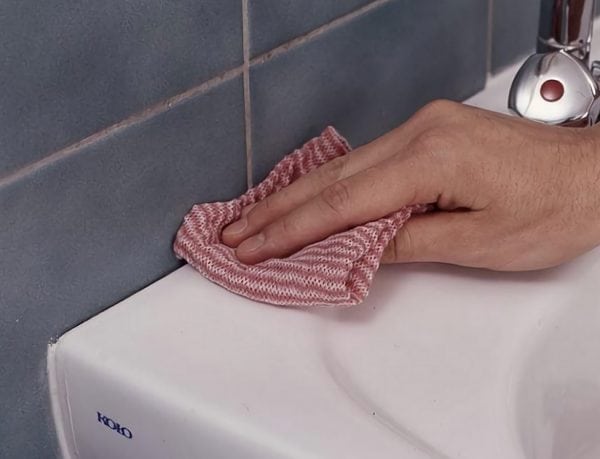Means for sealing are indispensable in the house. They prevent moisture from entering the joints of the tiles, in the cracks between the tile and the bathroom, and seal the joints in the pool, in the kitchen. Sealants are very easy to use, but you must proceed with extreme caution during repairs.
- Description of composition
- Sealant Removal Methods
- Mechanical methods
- Chemical methods
- How to remove sealant in the bathroom
- Tile cleaning
- Plastic cleaning
- Glass and mirror cleaning
- Countertop stain removal
- How to wash clothes
- Washing off sealant from hands
- Useful Tips

If it gets on any surface, it will have to be washed off with great effort. This is due to the ability of the product to be absorbed into the base structure. How to remove silicone sealant? The method will depend on the type of surface and the "freshness" of the stain.
to contents ↑Description of composition
Silicone is a universal substance that has the ability to seal various holes, is soft, plastic. Based on it, sealants are made - adhesive compositions (transparent, white), after drying, gaining a dense uniform structure. A good sealant is resistant to solvents, to mechanical damage, otherwise it would not be able to carry out its functions. At home, it is used for:
- aquariums;
- interior doors;
- windows;
- Bathrooms
- ovens;
- refrigerators;
- bathrooms.
to contents ↑Of all sealants, it is silicone that is most difficult to remove in case of unwanted contact with the surface. The process will take time, is time consuming.
Sealant Removal Methods
Why should the sealant be removed immediately after its discovery, since many materials are colorless and almost invisible? Very quickly, the glue stain will darken, due to the peculiarities of the structure, it is subject to contamination. Also, the removal of the adhesive joint is shown in the bathroom and in the kitchen - with frequent contact with water, it can peel off, and it must be replaced with a new layer.
How to remove glue without consequences for the surface of the product? There are several methods to cleanse the foundation:
- softening (dissolving) with chemicals;
- scrubbing;
- cutting and scraping;
- laundering.
to contents ↑In some cases, it is easier to remove the sealant mechanically, gradually cutting it off and cleaning the residue. In other situations, it is better to use a "silicone remover" - a special solvent.
Mechanical methods
To clean the sealant by hand, any convenient tool is suitable. It is most effective to use a sharp knife, metal spatula, scraper. Here are some guidelines for using them:
- Putty knife. Perfect for cleaning all surfaces. Before work, you need to make sure that its edge is even, not nicked. This is required to prevent scratches on the product. If this seems more convenient, you can detach the glue with the corner of a spatula.
- Stationery or shoe knife. The pointed tip can be used to clean protruding silicone deposits. Care must be taken not to get hurt.
- Razor blade. It must be used with special accuracy, work only with gloves. A razor is not used on plastic - there is a high risk of scratches.
- Old bank card. They are made of plastic, they do not leave microdamage on surfaces. But with a credit card you can remove only small-sized spots from a smooth surface - from glass, tile.Cards are ideal for the combined method - first you need to dissolve the stain with a special tool, and then remove the remaining credit card.
You can also deal with sealant if you carefully clean the surface with any abrasive - soda, salt, bath powder. Suitable sandpaper, pumice, metal brush for dishes. Large excess glue must be cut off with a knife, then moisten a washcloth or cloth, squeeze well, apply an abrasive substance. After you wash off the particles with water. Follow with gentle circular motions.
to contents ↑Chemical methods
In construction stores, a variety of tools are sold that can seal off the sealant. They differ in composition and are suitable for a particular type of glue; they are one- and two-component. The latter are almost never used in everyday life, it is difficult to breed them, so you need to buy a one-component tool. Solvents are of the following types:
- acidic;
- neutral, including: amide, amine, alcohol, oxide.
Silicone sealants, as a rule, have an acid base - even when applied, a specific smell of vinegar can be noted. Therefore, it is best to buy an acid solvent - it will help to peel off the influx. If there is no special product, acidic sealant can be washed with vinegar essence. Alcohol sealants are less common, they tend to dissolve in 96% alcohol (food, technical). All other adhesives are removed by such means:
- petrol;
- solvent;
- White Spirit;
- acetone;
- solvent 647.
Universal liquids for removing any sealant are Penta-840, Antisil, Silicon-Entferner solvents. They recommend that you remove large stains of material, as well as clean old seams before replacing with new ones. But we must remember: despite the power of the action, even with such means you can not get rid of stains of polyurethane foam sealant. It will have to be removed manually, mechanically.
to contents ↑How to remove sealant in the bathroom
Washing silicone or other sealant between the bathroom and the tile can be difficult. A sharp knife should be prepared - without cutting, a thick layer of material will not peel off. A knife cuts the seam along the entire length, then picks it up from the bottom. Then you can tear off the bulk of the material, but its traces will still be very noticeable. You can clean them with:
- pumice
- salts;
- abrasive detergent;
- vinegar
- solvent.
If it was not possible to glue the sealant neatly, spots remained on the bath, until they finally harden, they are easily removed with vinegar. When the glue had time to harden, grease it with vinegar for the night. The sealant is removed very carefully from the acrylic bath, the surface is sensitive to friction and scratches. A little white spirit is applied to the stain, after 15 minutes the product is carefully removed with a wooden scraper. The residue is wiped with a dry cloth, then washed with water.
to contents ↑Tile cleaning
It is much easier to remove the sealant from the tile, because it is smooth, even, almost scratched. First, bulging sections of the spot are cut with a knife, after which kerosene and gasoline are used. They are rubbed into the surface with a rag until the hardened layer becomes soft. If there is no reaction, white spirit is used, in severe cases, the Penta-840 solvent is used. Before applying the latter, it is important to try the reaction of the tile in an inconspicuous corner. It happens that dull spots remain on the surface, it loses its gloss. Features of cleaning tiles are as follows:
- “Capricious”, expensive types of tiles must be cleaned with a wooden scraper;
- in a hard-to-reach place you can use not a knife, but a razor;
- withstand solvents at the spot for at least 2-3 hours, proceed to cleanse when the silicone becomes like jelly;
- clean the remaining dark spots with salt.
Plastic cleaning
The adhesion of plastic to the sealant is low, so the process of material removal will be quick, without problems. Any solvent is applied to the sewer pipes, plastic pallets, wait an hour, then the molten mass is removed. The residue is washed off with an ordinary detergent.
For fiberglass showers that had to be glued with sealant, experts recommend using the special Dow Corning OS-2. It is intended for the safe dissolution of difficult spots, while completely harming the plastic. The stain is treated with a solvent, after 30 minutes it is removed with a spatula.
to contents ↑Glass and mirror cleaning
Glass surfaces are most easily cleaned of silicone. Sometimes it’s enough to cut off the excess influx with a razor, knife, and then remove with any abrasive. For the final removal of stains from the mirror, the glasses use liquid to clean the glasses. Care must be taken so that there are no scratches. Old, hard spots need to be pre-treated with white spirit. Gasoline can not be used - after it will remain rainbow stains, which are problematic to remove.
to contents ↑Countertop stain removal
The best way to return clean a countertop will depend on the type of material it is made of. If the basis is porcelain, you can use any method - chemical, mechanical, mixed. There will be no harm to the countertop, it is difficult to scratch it.
to contents ↑The plastic bases must be cleaned with a knife, then wiped with a rag with salt, soda. Care should be taken - bright spots can remain on a poor-quality product. Chemicals are used by trying in an inconspicuous area. After dissolution, remove the remains with a scraper, then rinse with household products.
How to wash clothes
It happens that the sealant gets on the thing, remains on clothing. It is advisable to take action immediately. Tighten the fabric, pick up the stain with a hard thin object, remove the glue. When the sealant has absorbed, you have to act differently. The influx can be wiped with vinegar, then wash the tissue area manually. Many types of sealant are removed from clothing with alcohol - a toothbrush is moistened in it and traces are cleaned. Material will curl up and lag.
to contents ↑Washing off sealant from hands
Salt will help remove material from your hands. Pour warm water into a small basin, add a little salt. After they lower their hands in water, they begin to cleanse the product with pumice. Repeat the procedure 2-3 times, since the adhesive leaves the skin with difficulty. You can also well soap your hands with laundry soap and repeat the action with pumice.
Useful Tips
If you need to clean the sealant urgently, you can do this by heating. Thus, it is permissible to act on any surface where it will be convenient. First, apply a little vinegar to the glue, then attach a sheet of paper. After going through the sheet with a heated iron.
To clean the fabric from glue, freezing is often used. The thing is placed in the freezer, first you need to put it in a bag. After 3 hours, the adhesive is carefully removed with a sharp spatula. If there is no solvent at hand, small spots of the sealant can be eliminated with hydrogen peroxide. To avoid difficulties with cleaning the material, it is better to observe safety measures while working with it. Work should be in gloves, work clothes, to prevent glue from getting on the surface. For reliability, the latter are pasted over with masking tape, which will not allow the sealant to "go beyond."












